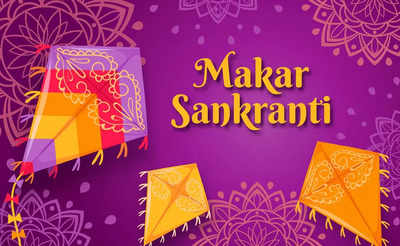Trending
When is Makar Sankranti 2025? History, Significance, story and all you need to know
Makar Sankranti is one of the most important and auspicious festivals in India, celebrated with great enthusiasm and joy every year. In 2025, Makar Sankranti will begin on Tuesday, the 14th of January, from 9:03 AM onwards. The Punya Kaal (auspicious period) will span a generous 8 hours and 43 minutes from 9:03 AM to 5:46 PM on January 14.
Makar Sankranti is one of the most important and auspicious festivals in India, celebrated with great enthusiasm and joy every year. In 2025, Makar Sankranti will begin on Tuesday, the 14th of January, from 9:03 AM onwards. The Punya Kaal (auspicious period) will span a generous 8 hours and 43 minutes from 9:03 AM to 5:46 PM on January 14.
This festival is the Sun's entry into the zodiac sign Capricorn (Makara), marking the beginning of its northward journey (Uttarayana). This is considered an extremely auspicious event and signifies positivity, renewal, and promises of fresh beginnings.
While Makar Sankranti invariably falls on the 14th of January in a year, it occasionally drops to January 15 during the leap years on account of astral corrections. When the sun starts its move northward and days begin growing longer, hope triumphs over despair, darkness gives way to light, evil is overruled by the good.
The history of Makar Sankranti
Mythological connections
Makar Sankranti is intertwined with various legends, adding layers of meaning to the celebrations:
The two most important ones are the story surrounding the festival where Lord Shani, Saturn and his father, Sun God, who don't exactly enjoy a cordial relationship, reunited on Makar Sankranti. Thereby, with this reconciliation signifying harmony and balance as well as forgiveness.
King Bhagiratha and Ganga: The other well known narration is that of King Bhagiratha who did intense austerities to bring the sacred Ganga from the skies to the earth. It was on this Makar Sankranti that Ganga came to cleanse his ancestors indicating rebirth, cleansing, etc.
Lord Vishnu's Victory: Another legend says that Makar Sankranti is a celebration of Lord Vishnu's victory over demons, and the end of negative forces. It is an eternal victory of good over evil.
Importance of Makar Sankranti
Makar Sankranti has great importance in terms of astronomy, agriculture, and spirituality.
Astronomical importance
This marks the day when the Sun moves into Capricorn and the period of Uttarayana begins. For six months, it is considered to be very auspicious as gods are believed to awake from their sleep and bless the earth with prosperity and happiness.
Importance in Agriculture
The end of the harvest season is nigh, that's how Makar Sankranti would be looked at by an agrarian society. It's about time one said goodbye to the agricultural field, thanking the land, the Sun, and other natural aides that help sustain the human race. It is also the time of sowing new seeds, which means renewal and growth.
Spiritual symbolism
In a spiritual context, Makar Sankranti is a day for renewal and self-reflection. The northward journey of the Sun is a symbol of enlightenment and of the disposal of the shadows of ignorance. On this day, one says goodbye to all past grudges and welcomes positivity into one's life.
Rituals and celebrations of Makar Sankranti
Makar Sankranti is celebrated in many ways in the vast regions of India, but the theme is common - gratitude, renewal, and joy.
North India
In North India, especially in Punjab, it is celebrated a day before as Lohri, a harvest festival that unites people with bonfires. Folk songs, traditional dances such as Bhangra and Gidda, and festive feasts are the marks of the celebration. Families share sweets made from jaggery and sesame seeds, which signify unity and warmth.
South India
In Tamil Nadu and other parts of South India, Makar Sankranti is known as Pongal and is celebrated for four days. It is a time to pay homage to the Sun God, cattle, and the Earth for a bountiful harvest. A special dish called Pongal, made with freshly harvested rice, milk, and jaggery, is prepared and offered to the deities. Homes are decorated with beautiful kolam (rangoli) designs, and people wear traditional attire to mark the occasion.
West India
The kite flying is a hallmark of the Makar Sankranti celebrations in Gujarat and Rajasthan. People from all walks of life gather on the rooftops and fill up the sky with colorful kites. The activity symbolizes ascent of the spirit and the joy of freedom. Special delicacies like undhiyu, sesame-jaggery sweets, are prepared and shared with the family and friends
East India
The celebration of Makar Sankranti is popularly known in West Bengal and other eastern states as the Ganga Sagar Mela. It is of the largest gatherings of devotees in India. Pilgrims take a holy dip at the confluence of the Ganga and the Bay of Bengal to cleanse their sins and attain spiritual merit. Traditional sweets made of date palm jaggery and coconut, such as pithe and patishapta, are savored during this time. In the states of Bihar and Jharkhand people eat Dahi Chura and Tilkut during the day and Khichdi during the night.
Central India
Makar Sankranti is a festival of folk dances, fairs, and community feasts in Madhya Pradesh and Chhattisgarh. In Maharashtra, sesame and jaggery sweets, tilgul, are exchanged with the phrase, "Tilgul ghya, goad goad bola," which translates to "Accept this sweet and speak sweetly."
A festival of togetherness
Makar Sankranti beyond rituals is actually a festival of togetherness and thanksgiving. Families hold hands together making festive meals, exchanging gifts and participating in other cultural activities, it's that day when relationships are built to remember the bygone year, and walk hand in hand in new opportunities that await us.
End of Article
FOLLOW US ON SOCIAL MEDIA
Visual Stories
Tired of too many ads?go ad free now











